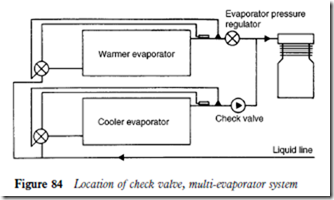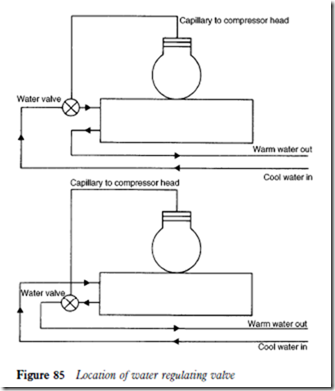Evaporator pressure regulator
This valve is fitted in the suction line to control the pressure in the evaporator, to prevent it dropping below a predetermined pressure. It is used to control the evaporating temperatures of systems such as drinking water fountains and beverage coolers, to maintain a constant evaporator pressure/temperature and prevent freezing.
It is also used in multi-evaporator systems, when it is installed in the suction line of the warmest evaporator. Check valves or one-way valves are necessary to prevent migration of refrigerant from the warmer to the cooler evaporators during off cycles (see Figure 84).
Water regulating valve
The pressure operated type is the most popular. It is employed in water cooled systems to control the flow rate through the condenser, modulating in response to changes in the condensing or operating head pressure.
It is designed to stop the flow of water to the condenser when the plant is at rest. An increase in the head pressure will open the valve to allow a greater volume of water through the condenser. A decrease in head pressure will automatically reduce the volume of water flowing through the condenser.
The location of the valve may vary; it may be installed at the inlet to the condenser or at the outlet. Current practice is to install it at the condenser outlet, to ensure that the condenser does not drain when throttling takes place during operation and normal modulation of the valve. Figure 85 shows the valve installed in both positions.
The valves are adjustable. As a guide to operating conditions, the valves should be adjusted to maintain a temperature difference of 7 9 °C (15 18 °F) between the inlet and the outlet water.

